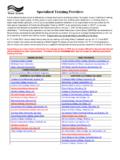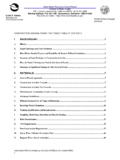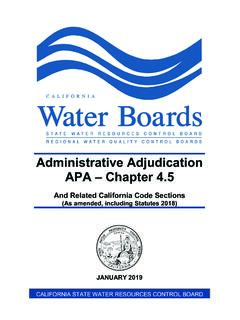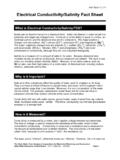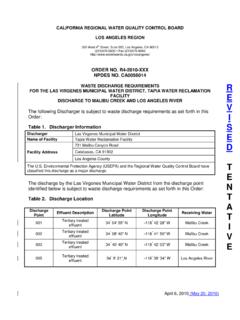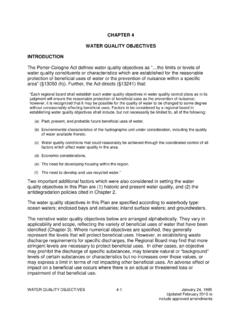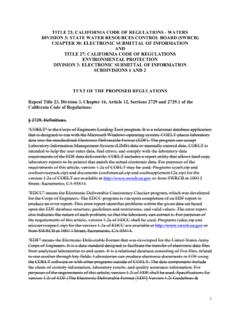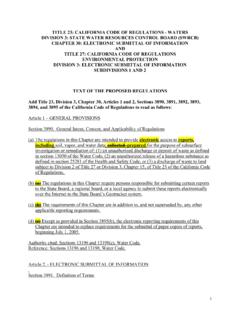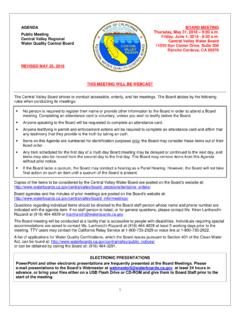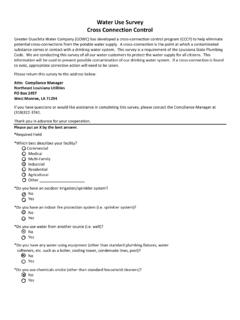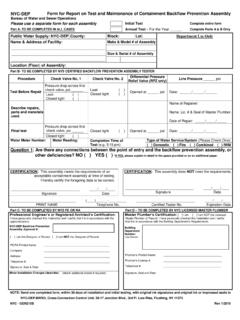Transcription of Drinking Water Distribution Exam Expected Range of Knowledge
1 Expected Range of Knowledge for Drinking Water Distribution Exam Number of questions by Exam Grade Content Category D1 D2 D3 D4 D5 Disinfection 15 20 20 15 10 Distribution System Design / Hydraulics 20 20 15 10 10 Equipment Operation / Maintenance / Inspections 20 20 25 20 15 Drinking Water Regulations / Management / Safety 15 10 15 35 45 Water Mains and Piping 20 20 15 5 5 Water Quality / Water Source 10 10 10 15 15 Disinfection Water Main Disinfection Well Disinfection Disinfectant By-Products Chloramination Chlorine Curve Chemistry Storage Reservoir Disinfection Types of Disinfectants Distribution System Design / Hydraulics System Layout Storage Facilities Service Connections Systems Map Assess System Demand Flow Rates and Velocity Head Loss Cavitation Water Hammer Water Pressure and Volume Static and Dynamic Pressure cross - connection and backflow Devices Equipment Operation / Maintenance / Inspections Valves Water Meters Hydrants Chemical Feeders Corrosion In-Line Sensors Power Generators SCADA Pump Types, Uses, and Sizes Water Horsepower Wells (New and Abandoned) Equipment Installation and Repair Troubleshoot and Repair Pumps and Motors Inspection of Water Mains, Piping, Storage Tanks Drinking Water Regulations / Management / Safety Disinfection-By-Product Rule Lead and Copper Rule MCLs Public Notification Safe Drinking Water Act Total Coliform Rule Emergency Response Planning Future Planning Maintenance Plan Safety Plan Water Conservation Planning Water Rates Administer Compliance, Budgets Monitoring and Sampling Requirements Operator Certification Regulations Expected Range of Knowledge for Drinking Water Distribution Exam 2 Rev.
2 4/2020 Water Mains and Pumping Cleaning and Maintenance Excavation Installation and Repair Joints and Fittings Leak Detection and Repair Pipe Selection Service Line InstallationWater Quality / Water Sources Coliform Group Corrosivity Heterotrophic Bacteria Unidirectional Flushing Waterborne Diseases Groundwater and Wells Sanitary Survey Organic and Inorganic Compounds pH, Conductivity, Hardness, and Turbidity The tables below list specific objectives in each content category. The specific exam grades where these objectives are included are also provided below. Disinfection Water Main Disinfection D1 - D5 Knowledge of Water main disinfectant techniques D1 - D5 Knowledge of dechlorination techniques D1 - D5 Ability to apply disinfectant D1 - D5 Knowledge of AWWA disinfection standards for Water mains Well Disinfection D1 - D5 Knowledge of contamination sources in a well D1 - D5 Ability to calculate a disinfectant dosage D1 - D5 Knowledge of well disinfection techniques D1 - D5 Knowledge of Water depth measurement techniques D1 - D5 Knowledge of AWWA disinfection standards for wells D1 - D5 Ability to measure the Water depth in a well D1 - D5 Ability to calculate the volume of a well Storage Reservoir Disinfection D1 - D5 Knowledge of Water storage contamination sources D1 - D5 Ability to calculate the volume of a storage reservoir D1 - D5 Knowledge of storage reservoir disinfection techniques D1 - D5 Knowledge of AWWA disinfection standards for storage facilities D1 - D5 Ability to
3 Calculate a disinfectant dosage D2 - D5 Ability to choose the proper disinfectant technique D2 - D5 Ability to calculate the surface area of the interior walls of a storage reservoir D3 - D5 Ability to calculate CT Expected Range of Knowledge for Drinking Water Distribution Exam 3 Rev. 4/2020 Disinfectant By-Products D2 - D5 Knowledge of the causes of DBPs D3 - D5 Knowledge of DBP reduction methods D3 - D5 Knowledge of DBP formation D3 - D5 Knowledge of DBP compounds D3 - D5 Ability to recognize abnormal levels of DBPs in the Water Distribution system Chloramination D1 - D5 Ability to measure total chlorine D2 - D5 Knowledge of the chlorine curve D2 - D5 Knowledge of advantages/disadvantages of chloramination D2 - D5 Knowledge of chloramine compounds D2 - D5 Ability to calculate chlorine/ammonia ratio for chloramination Chlorine Curve Chemistry D2 - D5 Knowledge of the definition of breakpoint chlorination D2 - D5 Knowledge of the chlorine curve D2 - D5 Ability to recognize when breakpoint has been met Types of Disinfectants D1 - D5 Knowledge of the purpose of disinfection D1 - D5 Knowledge of contact time D1 - D5 Knowledge of causes of chlorine demand D1 - D5 Ability to monitor and interpret chlorine residual D1
4 - D5 Ability to calculate a dosage D2 - D5 Knowledge of disinfectant types and characteristics D2 - D5 Knowledge of factors affecting chlorine disinfection D2 - D5 Knowledge of chlorine analysis techniques D3 - D5 Knowledge of chlorine chemistry Distribution System Design / Hydraulics Assess System Demand D1 - D5 Knowledge of unit conversions D2 - D5 Knowledge of the terms, peak demand, peak hour demand, maximum daily demand, and per-capita demand cross - connection and backflow Devices D1 - D5 Knowledge of conditions that cause backflow D1 - D5 Knowledge of available backflow prevention methods D1 - D5 Knowledge of back-pressure and back-siphonage conditions Expected Range of Knowledge for Drinking Water Distribution Exam 4 Rev. 4/2020 D1 - D5 Ability to recognize a potential backflow hazard D1 - D5 Ability to recognize a cross - connection Service Connections D1 - D5 Knowledge of service connection materials and fittings D1 - D5 Ability to tap a Water main D2 - D5 Knowledge of recordkeeping requirements Storage Facilities D1 - D5 Ability to calculate the volume of a storage facility D1 - D5 Ability to calculate flow rates for a storage facility D2 - D5 Knowledge of the types of storage facilities and their applications D2 - D5 Knowledge of storage facility corrosion control methods D2 - D5 Knowledge of storage facility components D2 - D5 Ability to drain, clean, and disinfect a storage facility System Layout D1 - D5 Knowledge of grid, tree, arterial.
5 And dead end Water systems D2 - D5 Ability to differentiate between a trunk line and a transmission line D4 - D5 Ability to calculate a hydraulic gradient System Maps D1 - D5 Knowledge of pressure/elevation relationships D2 - D5 Knowledge of map types D2 - D5 Ability to interpret map symbols D2 - D5 Ability to convert a scale to actual distance Flow Rates and Velocity D1 - D5 Ability to convert units of volume, area, and time D1 - D5 Ability to calculate the volume of a pipe D1 - D5 Ability to calculate the area of a pipe cross -section D1 - D5 Ability to calculate a flow rate D2 - D5 Ability to calculate Water velocity Head Loss D2 - D5 Knowledge of the relationship between head loss and friction D3 - D5 Knowledge of the effect of corrosion on head loss Cavitation D2 - D5 Knowledge of the causes of cavitation Expected Range of Knowledge for Drinking Water Distribution Exam 5 Rev. 4/2020 D2 - D5 Ability to recognize the signs of cavitation Water Hammer D1 - D5 Knowledge of Water hammer reduction techniques D1 - D5 Knowledge of the definition of Water hammer D1 - D5 Knowledge of the causes of Water hammer D1 - D5 Ability to calculate the surface area of a valve face D2 - D5 Ability to calculate total force on a valve Water Pressure and Volume D1 - D5 Ability to convert units of volume, pressure and area D1 - D5 Ability to calculate the volume of a cylinder, rectangle, and square Static and Dynamic Pressure D1 - D5 Knowledge of the relationship between Water velocity and Water pressure D1 - D5 Ability to recognize abnormal pressure readings (too high or too low)
6 D1 - D5 Ability to read and interpret a pressure gauge D1 - D5 Ability to convert pressure to feet of head Equipment Operation / Maintenance / Inspections Valves D1 - D5 Knowledge of proper valve installation D1 - D5 Knowledge of valve types and applications D1 - D5 Knowledge of the principles of operation of valves D1 - D5 Knowledge of pressure regulating valve maintenance D1 - D5 Ability to recognize a malfunctioning valve D2 - D5 Knowledge of pressure ratings Water Meters D1 - D5 Knowledge of Water meter types and purposes D1 - D5 Ability to convert Water units D1 - D5 Ability to choose the correct meter size D2 - D5 Knowledge of mechanical parts of Water meters Hydrants D1 - D5 Knowledge of thrust blocks D1 - D5 Knowledge of pressure requirements D1 - D5 Knowledge of mechanical parts of hydrants D1 - D5 Knowledge of hydrant types D1 - D5 Ability to flush using a hydrant Expected Range of Knowledge for Drinking Water Distribution Exam 6 Rev.
7 4/2020 Chemical Feeders D1 - D5 Ability to read a graduated cylinder D1 - D5 Ability to calculate a dosage D2 - D5 Knowledge of chemical feeder types D2 - D5 Knowledge of chemical feeder components D2 - D5 Ability to troubleshoot a chemical feeder Corrosion D2 - D5 Knowledge of type and applications of cathodic protection devices D3 - D5 Knowledge of the galvanic series D3 - D5 Knowledge of principles of operation of cathodic protection devices In-Line Sensors D2 - D5 Knowledge of required reagents and standards D2 - D5 Knowledge of analysis methods D2 - D5 Ability to recognize normal operation of in-line sensors Power Generators D1 - D5 Knowledge of start-up procedures D1 - D5 Knowledge of basic operation D4 - D5 Knowledge of power requirements ( efficiency) SCADA D2 - D5 Knowledge of the components of a SCADA system D2 - D5 Knowledge of communication techniques D2 - D5 Ability to interpret SCADA information Pump Types, Uses, and Sizes D1 - D5 Knowledge of pump types D2 - D5 Knowledge of operational principles of a Water pump D3 - D5 Ability to match pump type to application D3 - D5 Ability to interpret a pump curve Troubleshoot and Repair Pumps and Motors D1 - D5 Ability to recognize abnormal pump operating conditions D2 - D5 Knowledge of the mechanical components of pumps and motors D2 - D5 Knowledge of pump maintenance procedures D2 - D5 Ability to repair and replace pump and motor system components D3 - D5 Knowledge of recordkeeping requirements Expected Range of Knowledge for Drinking Water Distribution Exam 7 Rev.
8 4/2020 D3 - D5 Knowledge of when to MEG a motor Water Horsepower D3 - D5 Ability to calculate pump efficiency D3 - D5 Ability to calculate brake-horsepower D4 - D5 Ability to calculate the cost of pumping Water Inspection of Water Mains and Piping D1 - D5 Knowledge of proper backfill procedures and compaction D1 - D5 Knowledge of proper bedding techniques D1 - D5 Knowledge of pipe connectors and applications D1 - D5 Knowledge of compatible materials D1 - D5 Ability to recognize faulty or damaged pipe D1 - D5 Ability to recognize abnormal operating conditions D2 - D5 Knowledge of proper thrust restraint D2 - D5 Knowledge of proper disinfection techniques D2 - D5 Knowledge of allowable leak loss Inspection of Storage Tanks D1 - D5 Knowledge of security procedures/measures D1 - D5 Knowledge of safety equipment requirements D3 - D5 Knowledge of storage tank corrosion control measures Inspection of Equipment Installation and Repair D1 - D5 Knowledge of proper valve installation D1 - D5 Knowledge of proper hydrant installation D1 - D5 Knowledge of hydrant valve operation/testing D2 - D5 Knowledge of thrust restraint requirements D2 - D5 Knowledge of packing gland settings D3 - D5 Knowledge of proper pump alignment D3 - D5 Knowledge of proper phase balance Inspection of Wells (New and Abandoned) D1 - D5 Ability to calculate draw down D2 - D5 Knowledge of proper installation of a sanitary seal on a well D3 - D5 Ability to calculate specific yield D4 - D5 Knowledge of well abandonment procedures and permit requirements D4 - D5 Knowledge of proper gravel packing and screen depth D5 Knowledge of permit requirements Expected Range of Knowledge for Drinking Water Distribution Exam 8 Rev.
9 4/2020 Drinking Water Regulations / Management / Safety Disinfection By-Product Rule D2 - D5 Knowledge of Disinfection By-Product Rule sampling requirements D3 - D5 Knowledge of Disinfection By-Product Rule reporting requirements D3 - D5 Knowledge of Disinfection By-Product Rule MCL requirements Lead and Copper Rule D1 - D5 Ability to take a lead and copper sample D3 - D5 Knowledge of lead and copper sampling requirements D3 - D5 Knowledge of lead and copper rule reporting requirements D4 - D5 Ability to recognize a lead and copper rule violation Maximum Contaminant Levels (MCL) D1 - D5 Knowledge of the definition of MCL D2 - D5 Knowledge of maximum disinfectant residual level for chlorine D2 - D5 Ability to differentiate between a primary and secondary MCL D2 - D5 Ability to recognize MCL violations Monitoring and Sampling Requirements D1 - D5 Ability to read a sample siting plan D1 - D5 Knowledge of Water sampling techniques for bacteriological, organic, and inorganic constituents D1 - D5 Knowledge of holding times ( preservatives) Operator Certification Regulations D1 - D5 Knowledge of certification requirements Public Notification D1 - D5 Knowledge of acute violations D1 - D5 Knowledge of when public notification is required D4 - D5 Knowledge of required language to use D4 - D5 Knowledge of notification paths ( newspaper, electronic) Safe Drinking Water Act (SDWA)
10 D1 - D5 Knowledge of the purpose of the SDWA D1 - D5 Knowledge of the major components of the SDWA D2 - D5 Knowledge of reporting and recordkeeping requirements D3 - D5 Knowledge of non-compliance penalties Total Coliform Rule D1 - D5 Knowledge of Total Coliform Rule sampling requirements Expected Range of Knowledge for Drinking Water Distribution Exam 9 Rev. 4/2020 D1 - D5 Knowledge of Total Coliform Rule reporting requirements Administer Compliance, Budgets D1 - D5 Knowledge of OSHA/Cal-OSHA safety regulations D1 - D5 Knowledge of CDPH Water Quality regulations D3 - D5 Ability to calculate the cost of Water production D5 Knowledge of RWQCB discharge requirements D5 Knowledge of Air Quality Management regulations D5 Knowledge of the components of a budget ( revenues, expenditures, risk management, insurance costs, depreciation) D5 Knowledge of O&M budget components ( labor, professional services, supplies, energy, Water , capital improvement) Emergency Response Planning D1 - D5 Knowledge of the components of the Emergency Response Plan D1 - D5 Knowledge of system pressure zones D2 - D5 Knowledge of AWWA disi
